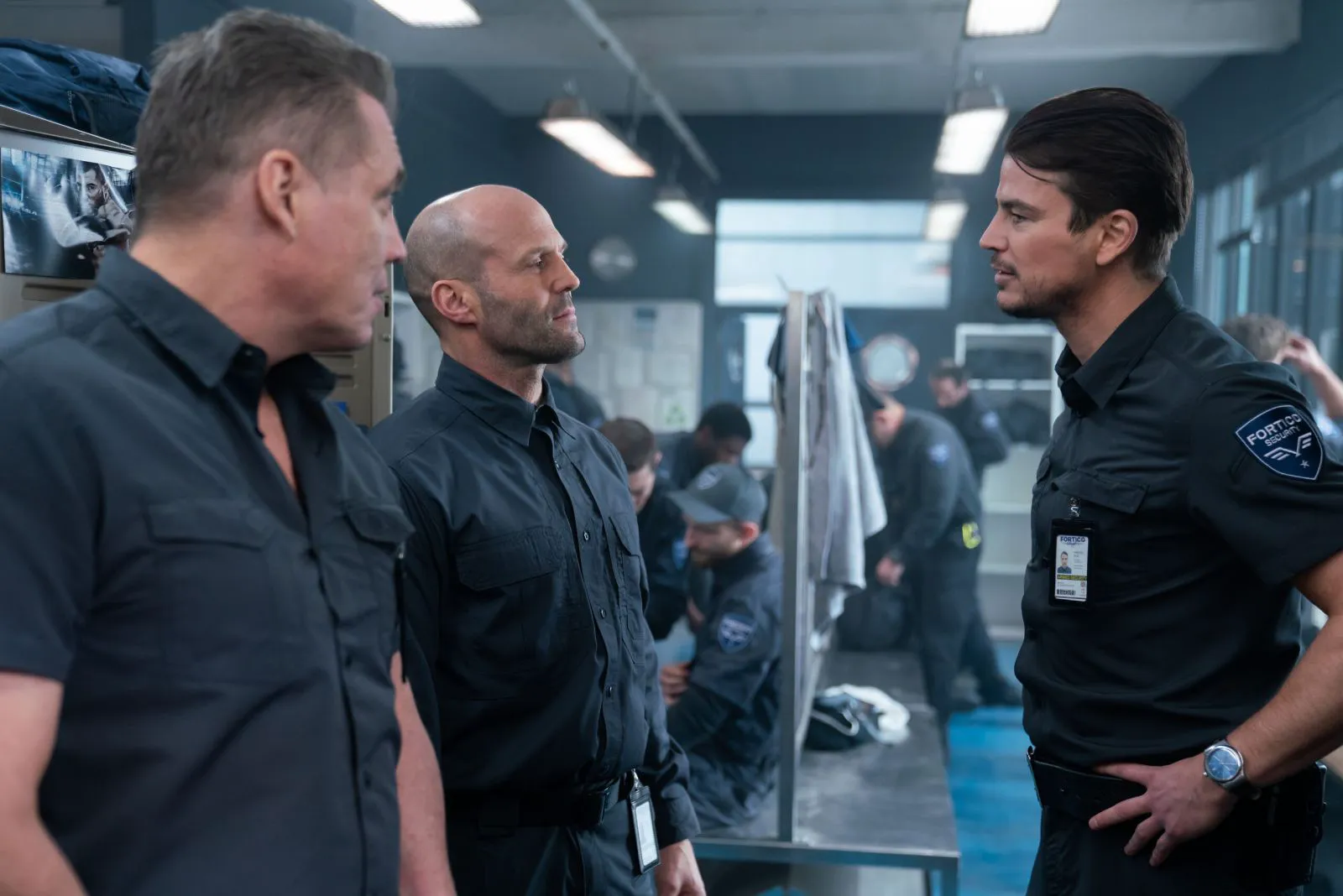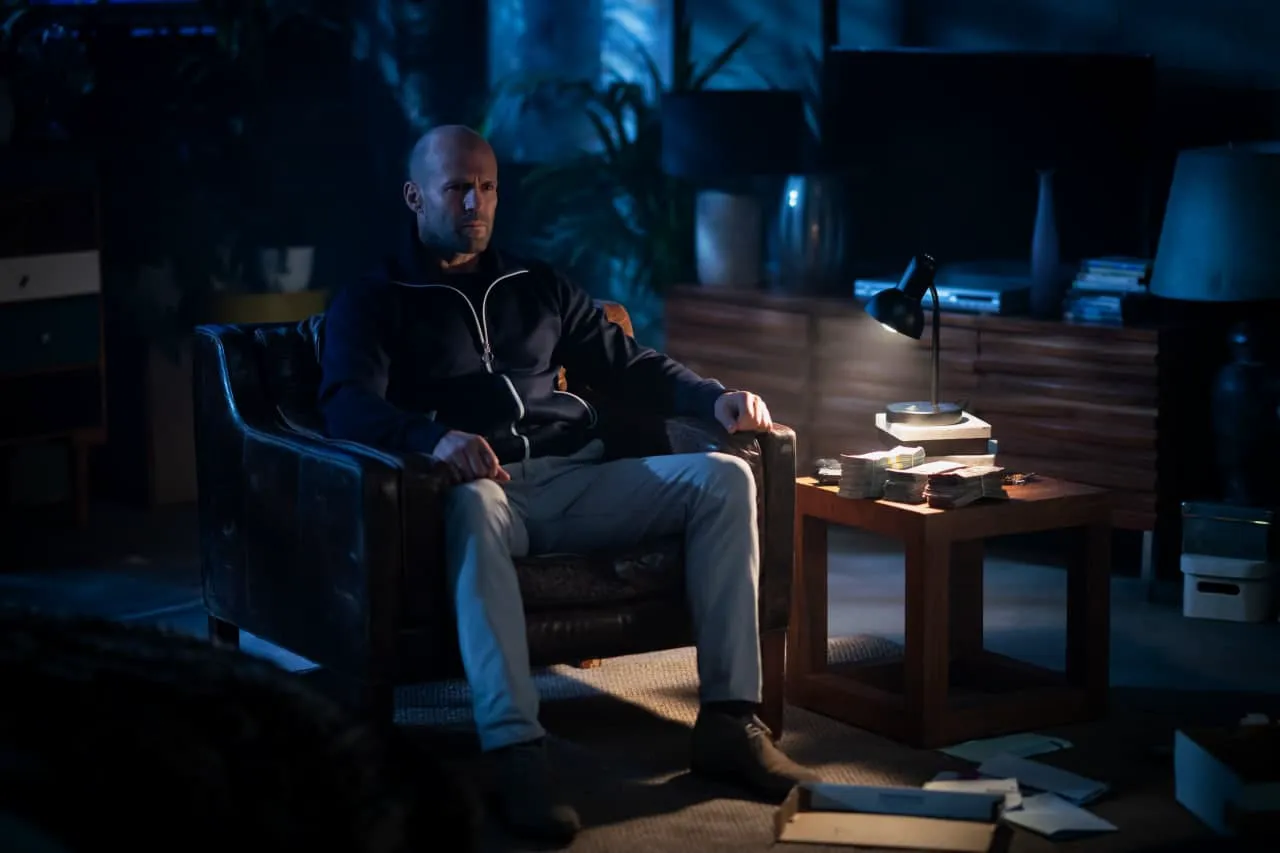A Testosterone-Fueled Thriller About Armored Truck Drivers, Starring a Suspiciously Cool Jason Statham (Even for Himself)
A fit, bald man (Jason Statham, who else?) comes for an interview at an armored truck company. He doesn’t talk much, doesn’t turn to face his future boss during the conversation, stubbornly staring at the wall while the boss mumbles somewhere behind him. And when he finally gets the job, he proves once again that he’s not destined to shine with sociability: he’s constantly silent at corporate parties and manages to make enemies among his colleagues in the first few days.
All armored truck drivers have call signs—Sticky John, Machine Gun—so our hero gets his nickname, H. You couldn’t come up with anything more boring, but H himself, let’s be honest, is a person without any distinguishing features. One thing is clear about him: he’s too cool for these greasy, washed-up armored truck drivers who spend their days trolling each other in the locker rooms and wearing out the seats of their work vehicles. Colleagues begin to suspect something when, during one of the attacks that have become more frequent in recent months, H coldly, almost with the composure of a professional killer, deals with the thieves. Now, ordinary workers, along with the audience, have to find out who Statham’s character is—a pig in a poke or a wolf in sheep’s clothing. And if he’s a wolf, is he performing in a circus?

Josh Hartnett as Dave in a still from “Wrath of Man”
When a lion is hungry, it eats. When Guy Ritchie wants to make a “lads’ movie” (almost always), he makes it. This time, it’s not some daring, ironic film about the lives of criminals who have retired, but a refined Statham movie where everyone speaks in hoarse, muffled voices, where any cool phrase turns into a pretentious quote for a meme with a wolf, and the main character forbids himself to die until he gets revenge. After making “The Gentlemen,” Ritchie seemed to decide to relax and spend a short, but still, marathon of Craig S. Zahler films (“Dragged Across Concrete,” “Brawl in Cell Block 99”) over the weekend. He did. He didn’t understand everything, but he learned the main lesson: if you replace the irony in your films with cold cynicism, something meta-laddish might come out.
Therefore, it’s very funny to perceive “Wrath of Man” as a remake of the original French thriller “Le Convoyeur” (and it is, as hard as it may be to believe). After all, Nicolas Boukhrief had a quiet drama about the boring everyday life of money transporters who smoke weed, chat about all sorts of nonsense, have fun at corporate parties, but are unable to hide their inner breakdown, their fatigue from life and themselves. Gradually, this plot focused more and more on the strange newcomer Alexandre, and the viewer found out why he went to work in armored transport. An awkward outsider, he revealed his true nature and turned into a cold-blooded avenger before our eyes. Change Dupontel (let’s just say, not at all heroic in appearance) to Jason Statham, and you get a completely different movie.

Jason Statham as H in a still from “Wrath of Man”
Guy Ritchie’s Take
But Ritchie needs it—that is, different. He doesn’t like to stand on ceremony with canons at all: his Holmes is not Holmes, King Arthur is a street thief, and only on “Aladdin” did the rebellion against everything generally accepted seem to stall. To “unstall” after a couple of films, turning almost a festival tragedy into a genre puzzle. Pretentious, of course, but Ritchie-style pretentious: again, these expressive opening titles, again, a non-linear narrative structure, and even a pretentious division into acts, the funniest of which is the duplication of chapter titles by the characters themselves (in “Scorched Earth,” H’s henchmen, for example, complain that they scorched the entire earth in search of the right people). There is no trace of the French film, but not much of the old, jocular Ritchie remains either.
He uses elaborate visual techniques more diligently than usual: he shoots the opening scene in one take, placing the camera in the armored truck that is about to be robbed, or uses sharp camera departures during a static dialogue. Ritchie, in short, is more interested in playing with the matter of the genre, transforming the standard Statham movie, where the actor known to everyone changes his profession again (from transporter and mechanic to armored truck driver) at the level of form. Ritchie’s legacy is precisely the images of masculine, bullying men who joke about members and make fun of each other between work, like eighth-grade bullies.
Stockholm Syndrome?
In this situation, when a self-ironic author, always hovering somewhere above the genre, takes on a story as simple as two times two and incredibly serious, there are two ways out. The first is to get something in the spirit of “Spy” with the same Statham. A thoroughly parodic movie that turns the hackneyed images of special agents into one big joke. The second is a post-ironic synthesis of these two forms, a concentrated genre alloy that is so outrageously vulgar and serious (and also aesthetically filmed) that this alone provides a certain pleasure. It turned out more like the second.
Perhaps all this is part of Stockholm syndrome. I really don’t want to believe that Ritchie simply took and made a seasoned male action movie with the star of “Crank” and the latest “Fast & Furious” movies. But there are too many strange elements in this equation that do not fit into the laws of logic for the answer to be so simple. Statham stubbornly communicates with lads’ quotes, because it is better to live one day as a wolf than a hundred years as a jackal, and kills enemies (mainly child pornography dealers and murderers, after all, he is a noble avenger), but Ritchie, as if understanding how absurd his character is, simply enjoys the texture of the story. Perhaps that is why in the second half, H himself fades into the background and gives way to those he is actually going to take revenge on—war veterans abandoned by their homeland who rob armored truck cars.
It’s easier to imagine “Wrath of Man” as a film about any episodic character of Guy Ritchie: say, about Boris the Blade (they have a lot in common with Statham, by the way—you can’t hit either of them). It’s easy to imagine this character in the background, in the backwoods of history—usually such colorful but monotonous characters fit perfectly into a hectic narrative, overflowing with images of thugs, mafiosi, and, so to speak, ordinary people who were unlucky enough to be caught between two fires. But if you give Boris the Blade the leading role and force him to growl pretentious phrases in broken English, while loading the whole story with biblical quotes, it will turn out, as you can understand, tiring. In “Wrath of Man,” Ritchie clings not to the characters, as it was before, but to the very texture of the story—to a series of events that jump through the chronology, sending the viewer from one point of the plot to another (pay attention to how often the inscriptions flash on the screen: “3 months ago,” “2 weeks ago,” “a long time ago in a galaxy far, far away”). Ritchie seems to have lost touch with his favorite types, and with it the sense of dynamics, which has been replaced by directorial graphomania. Instead of a movie—albeit spectacular, but still an exercise. Instead of some special look at the genre—a typical representative of it.